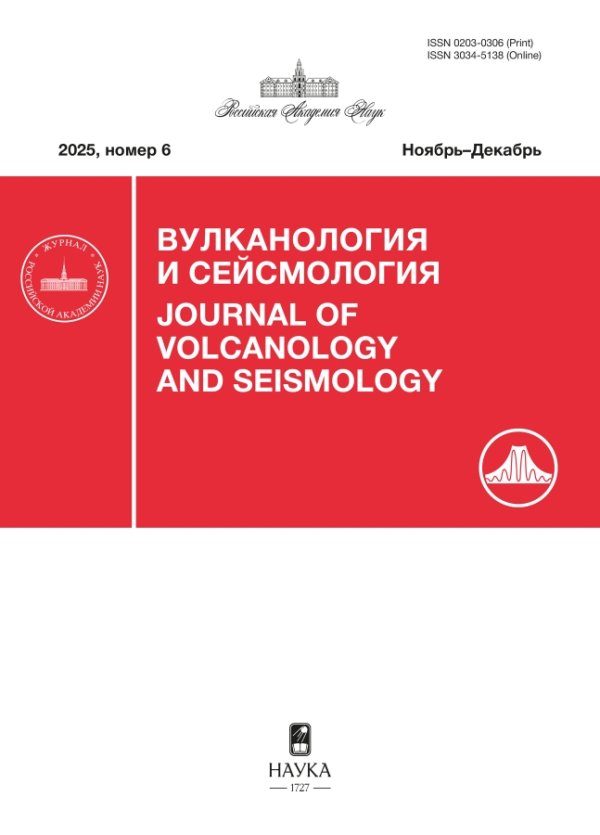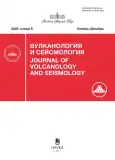Journal of Volcanology and Seismology
ISSN (PRINT): 0203-0306
Media registration certificate: No. 0110147 dated 02/05/1993
Founder: Institute of Volcanology and Seismology, Far Eastern Branch of the Russian Academy of Sciences (Petropavlovsk-Kamchatsky), Russian Academy of Sciences (Moscow)
Editor-in-Chief: Sobisevich Alexey Leonidovich Doctor of Physical and Mathematical Sciences, Corresponding Member of the Russian Academy of Sciences
Number of issues per year: 6
Indexation: RISC, List of Higher Attestation Commissions, RSCI Core, white list (2nd level)
Journal of Volcanology and Seismology is an international peer-reviewed journal that publishes theoretical and experimental studies, communications, and reports on volcanic, seismic, geodynamic, and magmatic processes occurring in the areas of island arcs and other active regions of the Earth. In particular, the journal looks at present-day land and submarine volcanic activity; Neogene–Quaternary volcanism; mechanisms of plutonic activity; the geochemistry of volcanic and postvolcanic processes; geothermal systems in volcanic regions; and seismological monitoring. In addition, the journal surveys earthquakes, volcanic eruptions, and techniques for predicting them. The journal welcomes manuscripts from all countries.
Current Issue
No 6 (2025)
Articles
INTEGRATED EARTHQUAKE CATALOG OF THE RUSSIAN ARCTIC, 1962–2024
Abstract
The article describes the updating and actualization of the earthquake catalog of the Arctic zone of the Russian Federation (AZRF), which combines all available data from Russian and international seismological agencies, bringing the magnitudes to a homogeneous scale. The first version of the catalog was presented in 2022–2023. The catalog of the Eastern Sector of the Russian Arctic contained data till 2020, and the Western Sector and territories of the Arctic Ocean till 2022. Since then, a significant amount of new data has accumulated: the collections “Earthquakes of Russia” have been extended until 2023, “Earthquakes of Northern Eurasia” – until 2021, and the catalog of the International Seismological Center (ISC) – to the present. Due to different network configurations and record processing methods, agencies may register/skip different events. For this reason, combining earthquake data from various seismological agencies makes it possible to obtain the most comprehensive catalog for the region under study. When combining earthquake catalogs, the problem arises of identifying and deleting duplicates (records related to the same seismic event). To solve this problem, this paper uses a new fully automated version of the modified nearest neighbor method based on the analysis of the metric distribution in the network error space when determining epicenters and times of seismic events. The unification of magnitude estimates is based on a regression analysis of different types of magnitudes performed during the creation of the first version of the combined catalog. The updated catalog contains 53 777 earthquakes.
 3–17
3–17


DIRECTION FINDING OF EARTHQUAKE EPICENTERS BY LASER STRAINMETERS
Abstract
The article considers the possibility of determining the direction finding on the epicenters of earthquakes located at significant distances from the locations of laser strainmeters using the triangulation method, based on the data from laser strainmeters, located on Cape Shultz in Primorsky Krai, near the city of Krasnokamensk and the village of Neutrino (Kabardino-Balkarian Republic). Additionally, a method for localization of sources of various vibrations based on the use of data from a two-coordinate laser strainmeter is considered. The ways of improving the obtained results are described, based on the use of additional laser strainmeters in the system of spatially distributed laser strainmeters, which are currently in operation of recording variations in deformations of the earth's crust on Popov Island and in the Crimea. The obtained results confirm the possibility of using the created planetary laser interferometric seismoacoustic observatory for recording and bearing sources of natural and artificial signals at any planetary distances.
 18–30
18–30


VILYUCHINSKOYE EARTHQUAKE APRIL 3, 2023 Mw 6.6 IN AVACHA GULF (KAMCHATKA)
Abstract
The paper presents the results of the analysis of macroseismic and instrumental data of the earthquake that occurred on April 3, 2023 at 03:06 UTC in the southern part of the Avacha Gulf (Kamchatka) at a depth of ~105 km. This earthquake was named “Vilyuchinsk earthquake” – its epicenter was located 47 km from Vilyuchinsk town. It was felt in the range of epicentral distances Δ up to 555 km. Maximum shaking with intensity I = 5–6 was recorded at four locations (Δ = 40−62 km), including Petropavlovsk-Kamchatsky and Vilyuchinsk. Peak ground motion accelerations exceeded 20 cm/s2 on records from 23 digital accelerograms (Δ <101 km). This earthquake was accompanied by a series of aftershocks lasting about 400 days. Estimates of the dimensions of the main shock source (~23 km × 15 km) were obtained from the size of the aftershock area. Waveforms from regional seismic stations were used to determine the basic source parameters of the main event and its strongest aftershock: moment magnitudes Mw (6.6/4.9), depths of the equivalent point source he (95/110 km), and focal mechanisms. The compressional axes of both mechanisms are oriented approximately along the dip of the subduction zone. Many earthquakes in the vicinity of the Vilyuchinsk earthquake have similar focal mechanisms. It can be assumed that the upper layer of the subducting plate, to which the source of the Vilyuchinsk earthquake belongs, is in a state of compression in the direction of the dip of the plate. The earthquake was preceded by anomalous variations of a number of seismological, hydrogeochemical, hydrogeodynamic, geoacoustic and electromagnetic parameters. In 4 cases, the anomalies detected in real time were used to successfully predict the location, time and magnitude of the expected event. Postseismic variations of groundwater flow rate and mineralization with a duration of ~260 days were detected at one of the Pinachevsky springs (Δ ~80 km).
 31–49
31–49


FOCAL MECHANISMS OF VOLCANIC-TECTONIC EARTHQUAKES OF KLYUCHEVSKOY VOLCANO
Abstract
Periods of activation of Klyuchevskoy Volcano eruptions and its quite period were accompanied by strong, (KS1,2 0.68 > 6.9) volcano-tectonic (VT) earthquakes beneath the basement. In this paper we have solved focal mechanisms of strong (VT) earthquakes of Klyuchevskoy Volcano and made a mapping on the Wulff grid (lower hemisphere). Focal mechanisms of strong (VT) earthquakes were determined using the out-of-the-box developed algorithm for the FPFIT programme, based on polarities of the first P-wavesarrivals. As initial data we used waveforms of seismic signals recorded by 19 radio-telemetric seismic stations installed within Klyuchevskoy Volcano, which gave us the parameters of 14 individual source mechanisms of strong (VT) earthquakes. Both solving and constructing of the focal mechanisms helped us obtain different types of movements in the foci of these focal mechanisms. During periods of activation of Klyuchevskoy Volcano, surface events succeeded by deep events are recorded; during the quiet period, both deep and surface events beneath Klyuchevskoy Volcano are registered.
 50–60
50–60


TO THE ASSESSMENT OF GEODYNAMIC REGIMES OF VOLCANIC CENTERS
Abstract
Common features of the relief of the Nevado del Ruiz and Elbrus volcanoes have been revealed, which can be largely explained by the similarity of the geodynamic regimes of these volcanic centers. The established general patterns of orientation of lineaments, watercourses, elongation lines, configuration of ring elements of interpretation, as well as the modern seismic regime of the studied areas complement the ideas about the deep structure and state of magmatic feeding systems, emphasizing the need to control the nature of weak seismicity in the immediate vicinity of the Elbrus volcanic structure to clarify its volcanic hazard.
 61–74
61–74


LARGE SCALE COLLAPSES OF AVACHINSKY AND KORYAKSKY VOLCANOES AND THE ASSOCIATED CATASTROPHIC ERUPTIONS – THE MAIN DANGER FOR CITIES OF PETROPAVLOVSK-KAMCHATSKY AND ELIZOVO
Abstract
It is well known that large scale collapses of volcanic edifices (with volume more than 0.01 km3) are common natural phenomenon and usual stage in geological history of many volcanoes. Volcanic collapses produce high-velocity, devastating debris avalanches, which travel long distances. In many cases, large scale collapses also provoke strong explosive eruptions. We report geological data about deposits of a large scale edifice collapse (debris avalanche) of Avachinsky volcano with volume 12 km3. A major part of the city of Petropavlovsk-Kamchatsky is built on top of this debris avalanche deposit. We also report a new determination of the radiocarbon age of the organic-rich deposit underlying the avalanche deposit, which indicates that Avachinsky volcano collapsed 16500 14C years BP. We presume that modern edifices of Avachinsky and Koryaksky volcanoes are potentially ready for future large scale collapses. The considered scenarios of possible future collapses show that the resulted debris avalanches will be able to reach the cities Petropavlovsk-Kamchatsky and Elizovo. The results of our investigations allow to upgrade the existing maps of volcanic hazards for this area.
 75–92
75–92












